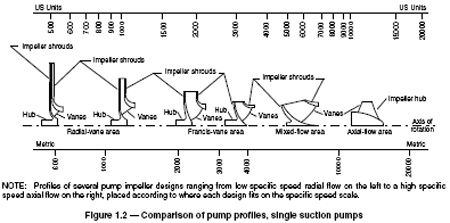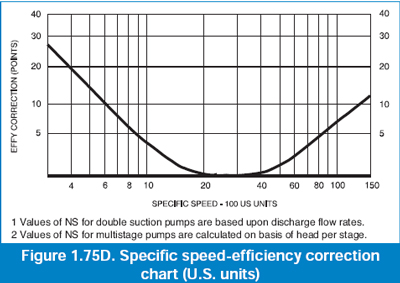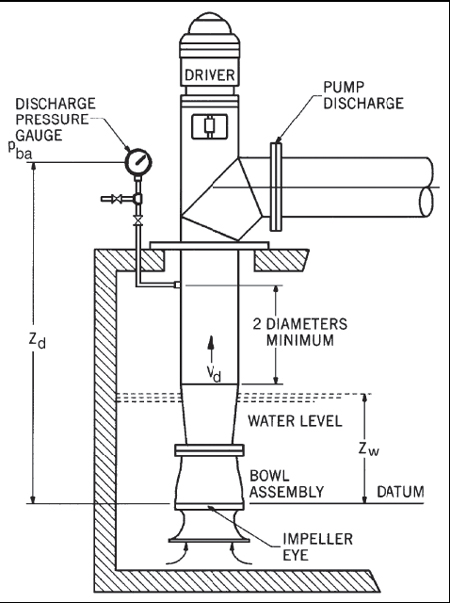Q. What is the definition of specific speed, to what does it pertain and how is it used?
A. Specific speed is an index of pump performance (developed total head) at the pump's best efficiency point (BEP) rate of flow, with the maximum diameter impeller, and at a given rotative speed. Specific speed is expressed by the following equation:
ns = nQ0.5/H0.75
Where:
ns = Specific speed
n= Rotative speed, in revolutions per minute
Q = Total pump flow rate, in cubic meters per second (U.S. gallons per minute)
H = Head per stage, in meters (feet)
The number relates to the profile of the pump impeller shown in Figure 1.2. With multistage pumps, the specific speed number is determined using the total head developed by only one of the impellers.
An alternative definition for specific speed is sometimes used based on flow rate per impeller eye rather than total flow rate. In a double suction impeller pump, when this alternative method is used, the resultant value of specific speed is less by a multiplying factor of 1/(2)0.5 , or 0.707 times less.

Figure 1.2. Comparison of pump profiles, single suction pumps
The impeller's geometry profoundly affects the performance characteristics including efficiency and the shape of the head versus rate of flow curve. The most dramatic is the effect on efficiency as shown in Figure 1.75D. The correction shown in the figure is the efficiency reduction in points.

See the Hydraulic Institute Standard ANSI/HI 1.3 Centrifugal Pumps for Design and Application for more information on this subject.
Q. Our pump room has many different pumps that are all noisy when operating. Is this normal?
A. A certain amount of noise is expected from any pump. Pumps with higher energy levels usually operate with higher noise levels. It is often found that at higher and lower rates of flow and lower NPSH margins, the noise changes from a sound characterized as sand sliding down a chute, to one of gravel or rocks. The change in sound level is often not distinguishable on a sound level meter, but the change in sound characteristic is detectable by the human ear. Gravel and rock sounds are usually caused by cavitation in the pump suction and may cause mechanical damage and can limit the allowable operating region (AOR). A noise test may be used to help evaluate the AOR.
Some relief from the noise can be obtained by operating the pumps closer to the BEP or replacing the noisier pumps with lower speed units.
Q. We would like to check the performance characteristics of a vertical turbine pump in the field. How can this be done?
A. Accurate performance testing is tedious, and many details must be carefully followed. The Hydraulic Institute Standard ANSI/HI 2.6 Vertical Pump Tests describes how it is done.
The most difficult measurement is for total head. Vertical turbine pump performance curves are usually published using the total head measurement of the bowl assembly. This means that the pump discharge pressure is measured in the pump column pipe at two diameters downstream from any pipe increaser after the pump bowl assembly.
See Figure 2.85. Note that the figure does not include any suction strainer on the pump. If a suction strainer is present, the friction loss through it must be determined and added to the total head calculation.

Figure 2.85. Bowl assembly head measurement
The total head can be calculated from the following equations:
Where:
Hba = Total head of bowl assembly in meters (feet)
p = Pressure in kPa (psi)
Z = Elevation in meters (feet)
v = Liquid velocity in m/s (ft/sec)
g = Gravity constant 9.81 m/sec2 (32.2 ft/sec2)
s = Specific gravity
Additional information that must be considered for performance testing is located in ANSI/HI 2.6, Vertical Pump Tests.
Pumps & Systems, October 2009

